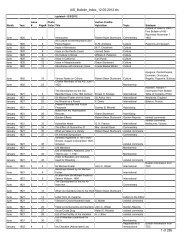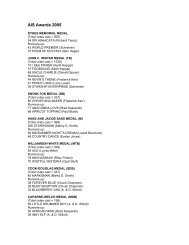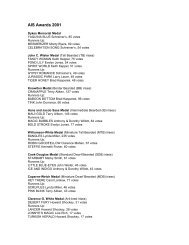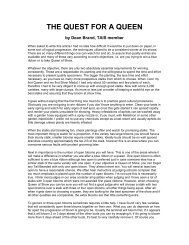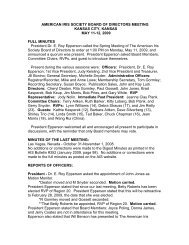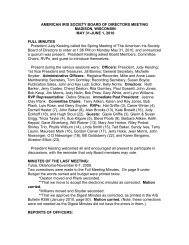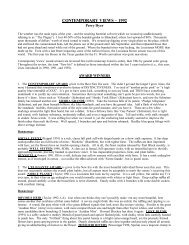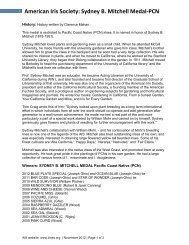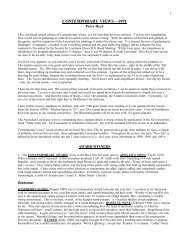contemporary views – 1988 award winners - American Iris Society
contemporary views – 1988 award winners - American Iris Society
contemporary views – 1988 award winners - American Iris Society
You also want an ePaper? Increase the reach of your titles
YUMPU automatically turns print PDFs into web optimized ePapers that Google loves.
The leader in blue amoenas continues to be DUTCH GIRL (K. Mohr 1981). I respect this iris more and more each<br />
passing year. Closed standards are sparkling white. Smoothest light blue falls glisten and have touching hafts. The<br />
whole flower has just the right amount of moderate ruffling to complement the broad, full-formed flowers. Quite a show<br />
iris, often opening 3 at once. But its major impact is in the garden. It has all the garden qualities the Mohr family insists<br />
on when introducing. Fat husky plants are disease-resistant and are vigorous. A good companion for ‘Holy Night’ (K.<br />
Mohr). CRANBERRY CRUSH (Aitken 1986) is my favorite of many fine ‘Mystique’ (Ghio) offspring on the market.<br />
This neglecta has light blue standards that are heavily infused with a surprisingly rare shade of cranberry violet in the<br />
midribs. This cranberry coloration is the solid color of the falls. The heavily ruffled, leathery flowers have an underglow<br />
that gives strong carrying power in the garden. The branching is inconsistent but acceptable. IN TOWN (Blyth <strong>1988</strong>)<br />
continues the tradition of ‘Magic Man’ (Blyth). It is your basic neglecta, but with a band around the falls in the lighter<br />
standards’ color. All this is then set off with a bright tangerine-red beard. Fairly smooth hafts. So far, a very weak grower<br />
in the Blanchard garden, with poor increase, but I’m willing to give it another year or 2 to kick in and grow properly.<br />
From the same bloodlines is WITCH’S WAND (Blyth <strong>1988</strong>), but much, much deeper and more intense. Technically a<br />
neglecta, but the contrast between the saturation in the standards and falls is minimal, although more so here than on the<br />
West Coast, where it almost looks like a dark violet approaching black self. The bright red beards are a breakthrough.<br />
Excellent form, and has smoother hafts and far better plants than ‘In Town’. Watch for this one! SPARKLING<br />
FOUNTAIN (Black 1989) is not from traditional blue amoena breeding, and you can see it in subtle differences in the<br />
flower. The standards are warm creamy white rather than the usual cold white such as ‘Dutch Girl’. The smooth light to<br />
medium blue falls possess diamond-dusting to give the flower carrying power, but the substance is as thick as leather.<br />
Elegant form.<br />
CLASSICS: MYSTIQUE (Ghio 1975); DOVER BEACH (Nearpass 1972); LIGHTED WITHIN (Blodgett 1980).<br />
BICOLORS:<br />
Oh, the star is EDITH WOLFORD (Hager 1986). The harmony achieved in combining these 2 colors that would<br />
normally clash has to be seen to be believed. Medium yellow standards have a hint of blue infusions that create perhaps<br />
even a suggestion of green in the heart of the flower. Gentle medium blue shades make up the falls, with an underglow of<br />
lavender that helps unite the two colors. The flowers have a billowing form, with a moderate but not overstated degree of<br />
ruffling. The shade of blue will vary, depending on temperature, humidity, the amount of moisture in the soil, time of day,<br />
and of course, mineral content of the soil and the grower’s cultural habits. Rather than a defect, this variance adds to the<br />
aura and mystique of the iris. It won Queen of Show in Oklahoma City this year. In this show-crazy state, I have seen<br />
dozens of shows the past 20 years, and the specimen of ‘Edith Wolford’ was the most perfect Queen of Show I’ve ever had<br />
the privilege of viewing. Second only to ‘Archie Owen’ (Hager, Spuria), ‘Edith Wolford’ is the finest release ever from<br />
Ben Hager. The surprise bicolor for me this year was SWEET MUSETTE (Schreiner 1986). A magnificent stalk won<br />
First Runnerup at the Norman (Oklahoma) show, and it shimmered under the artificial lights. A gentile combination of<br />
colors, with flamingo pink standards and soft rose-pink falls. The flowers have virtually no ruffling, yet are lightly laced.<br />
The Schreiners’ picture fails to capture the true colors and form. Needless to say, it has fine branching, with the specimen<br />
in Norman having 3 blooms open with perfect placement.<br />
Similar in the basic color pattern is ROLE MODEL (Denney <strong>1988</strong>), but the flowers are more opaque and have an overall<br />
burnished look. Standards are smooth melon-peach with some pink blended in. The falls are a combination of a deeper<br />
version of the standards, with old rose blended in. Harmonious tangerine beards. Most impressive show stalk branching<br />
and bud count on a first-year plant. Completing a trio of new offerings in this color pattern is WINIFRED ROSS<br />
(Hamblen <strong>1988</strong>), a refined extension of the pink-blue bicolor pattern begun 20 years ago with the release of ‘Touche’<br />
(Hamblen). The standards of ‘Winifred Ross’ are peach-pink and the falls are rose-purple, with a lighter area in the center,<br />
allowing the accenting orange-red beards to be more predominant. Leathery substance and blocky form. Begins blooming<br />
in the last half of the season.<br />
I consider SPRING SATIN (Black 1989) a breakthrough in the quest for haloed irises that began with ‘Bride’s Halo’<br />
(Mohr) in the early 1970s. ‘Spring Satin’s’ standards are similar to ‘Bride’s Halo’ <strong>–</strong> a glistening white, very finely edged<br />
in a gold halo of lace. The falls are pastel to light orchid-lavender, finely edged in a gold halo of lace. The falls are pastel<br />
to light orchid-lavender, even lighter around the harmonious yellow beards. The falls then have a laced halo of tan to gold,<br />
slightly wider than the standards’ halo. Elegant is an understatement. Ironically, ‘Spring Satin’ does not have ‘Bride’s<br />
Halo’ in its background. The merging of it with ‘Bride’s Halo’ and its progeny such as ‘Exuberant’ (Mohr) and<br />
Niswonger’s 3 new halo irises should be quite an event! SWEETER THAN WINE (Schreiner <strong>1988</strong>) was seen only once<br />
on a quick trip through Ketchum Garden in Memphis, but shows good potential. A glorified ‘Ringo’ (Shoop) or ‘Latin<br />
Lady’ (Shoop), it has light pink (approaching white) standards and deep, vibrant wine falls with a narrower band of the<br />
standards’ color than ‘Ringo’. The hafts are a bit noisy, and the flowers are narrower than desired, but it is still a rich,<br />
appealing color combination.<br />
22



